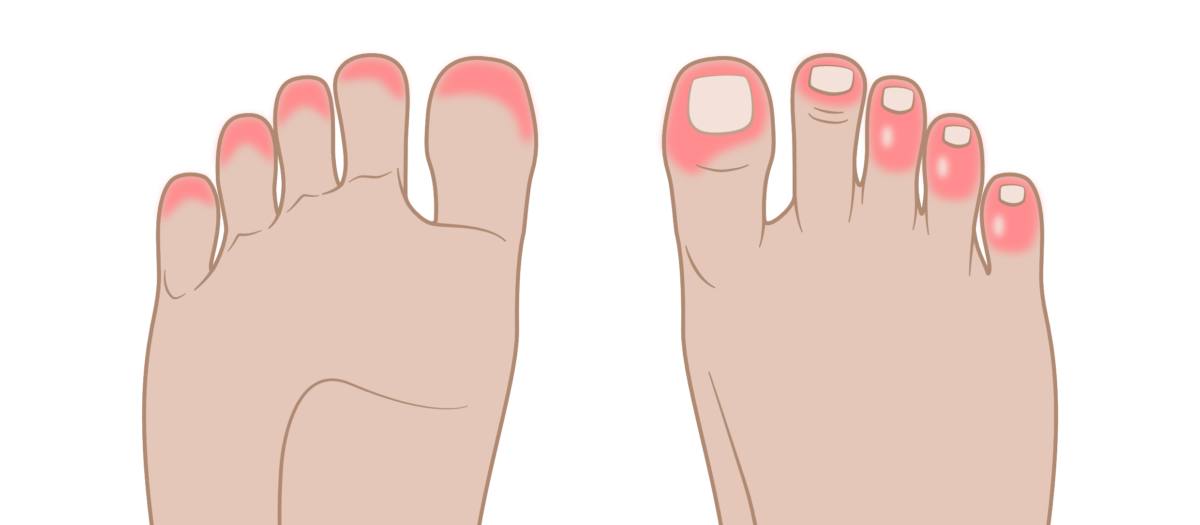Covid Toes and How To Help Avoid Them
What are Covid Toes
Since the arrival of covid-19, there have been numerous people complaining of purple/dark red patches or bumps around fingers and toes. They have caused itching, tenderness, burning, and sometimes pronounced pain. In appearance, they look just like chilblains, a common complaint associated with exposure to periods of cold followed by rewarming. In the feet these symptoms have been commonly reported since the first lockdown. Covid toe symptoms are reported in children receiving homeschooling, to adults of all ages forced to work at home.
There have been numerous reports of skin changes associated with people tested positive for covid-19. Virus infections commonly cause skin reactions. For example, consider measles, a viral infection famous for its spots. So the immediate thought was that all these chilblain-like toe lesions were a result of covid-19 infection as many people with these signs were testing positive for covid-19. Indeed in many cases, they may be a secondary consequence of the viral infection causing a thrombotic vasculopathy within the small blood vessels of the toes and skin generally. However, when tested for covid-19 many people with ‘covid’ toe don’t test positive. So what is going on? I got my own first case of ‘covid’ toe in April last year, but just thought it was a chilblain. It occurred after working long hours at a desk on the cold kitchen floor, without moving for hours, often with my toes extended. This is a position I usually find comfortable, but with the tips of both second toes becoming sore it no longer was. Then I developed deep red-purple patches and slight lumps on and around the ends of these toes causing pressure around the nails, but also sore to touch. Although I have never had chilblains before, as a 50 something and having seen many chilblains in my career I activated my chilblain prevention of foot exercises, and HealthyStep® Foot Pump socks, and within a few days it was resolved.
In the summer I started to hear reports of covid toe. In November after working in the kitchen again, in the same position during another cold lockdown it happened again! Did I have covid-19? I was sure I didn’t, so I tried the same treatment….problem gone. I’m now sticking to Foot Pump socks and making sure I walk about every 30 minutes.
So is the problem covid-19 directly or is it lockdown associated lifestyle changes? It certainly is possible that covid-19 infection can disrupt small blood vessels from the body fighting infection, but decreased levels of activity and extended periods barefoot or wearing just socks letting feet get cold can also cause a temporary ischaemia (blood supply reduction).
When skin and appendages like toes and fingers get cold blood vessels shut down to hold heat in. This is OK because tissues are colder, but when they warm up the blood must flow freely again or there will be a reaction. Foot temperature is usually much lower than body temperature at around 20 degrees centigrade (37 degrees is normal body temperature), but feet can often be much colder, especially in colder weather and when we are inactive, like in bed. Not moving around means that deoxygenated blood can pool in the feet. That is not good for the feet or our health generally!
So if you want to avoid covid toe, don’t sit still too long and don’t sit with your toes bent upwards as this narrows the blood vessels. Avoid working on cold floors barefoot or just in socks.
Do exercise your toes regularly (see our exercises), and walk about until your feet feel warm every 30 minutes.
If you get covid toe, try HealthyStep® Foot Pump socks; they’ll help keep the blood flowing freely, and maybe try our foot therapy ball to strengthen the muscles and produce heat in the toes.
I hope I won’t get another bout as I am now aware of the problem and know what to do to stop it happening again.


